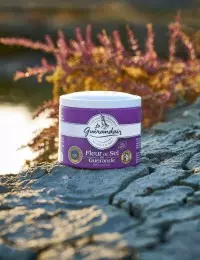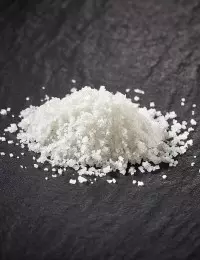
All about Fleur de sel de Guérande
Fleur de sel is a salt with a fine, delicate structure.
Discover all about this precious white gold.
Summary
Where does Fleur de sel de Guérande come from?
Fleur de sel de Guérande comes from the artisanal salt marshes of the Guérande peninsula. The agricultural harvesting of salt in this region was already practiced in antiquity, 400 years BC.
The salt marshes of Guérande have remained small, family-run, artisanal operations, today grouped into cooperatives where the salt workers themselves manage the marketing of their products. Sea salt and Fleur de sel are still harvested by hand, using artisanal tools.
While salt harvesting is an ancestral practice, Fleur de sel has long been neglected in favor of coarse sea salt.
Great chefs brought this white gold back into fashion in the 20ᵉ century by using fleur de sel to reveal the flavor of dishes: pan-fried foie gras with fleur de sel, chocolate and caramel moelleux with fleur de sel, gray shrimp with fleur de sel... Fleur de sel is featured on the menus of starred restaurants to the delight of gourmets.
How is Fleur de sel de Guérande produced?
From October to February, salt workers prepare the soil of the salt marshes, these large expanses made up of small basins separated by clay bridges . In early spring, they transport the seawater (loaded with 35g of salt per liter) into the œillets - the other name given to the crystallization basins.
Under the effect of sun, heat and wind, the seawater gradually evaporates and the water's salt concentration increases: the water is transformed into brine. Brine, or mother liquor, is in fact the name given to water with a high salt concentration after evaporation.
When the water has turned into mother liquor, the salt crystallizes. This is when harvesting begins, starting with the arrival of fine weather and continuing, as long as weather conditions allow, until early autumn.
Coarse sea salt and Fleur de sel are not formed in the same way. Coarse salt crystallizes on the clay bottom of the carnations, where it becomes loaded with trace elements, giving it its characteristic gray color.
Fleur de sel, on the other hand, appears on the surface of the ponds in the form of a thin opalescent film. It is the result of a number of natural factors: dry, sunny weather swept by an easterly wind, leading to the formation of inverted pyramid-shaped crystals that float on the surface of the water.
A true treasure of salt marshes, Fleur de sel is very fragile. Its harvest depends largely on the weather: if it rains while it's forming or just afterwards, the fleur de sel disappears. It's a rare product, a precious gift of nature.


How is Fleur de sel de Guérande harvested?
The Fleur de sel is harvested using the lousse, a tool that could be compared to a skimmer attached to a long handle, which enables the salt worker to collect the salt from the edge of the basins. The salt worker slides the lousse to the surface with a sure hand, as the slightest jerk would be fatal to the harvest of an entire eyelet. Harvesting is done by hand in the late afternoon, using skills handed down from generation to generation.
.
What's so special about Fleur de sel from the Le Guérandais cooperative?
Fleur de sel de Guérande is 100% natural, unadded and unprocessed salt. After harvesting, it is drained for 2 to 3 years before being offered for sale.
Since 1989, the cooperative Le Guérandais is a member of the Nature et Progrès federation, which advocates the practice of peasant farming, a sharing economy on a human scale and respect for the environment.
By choosing Fleur de sel Le Guérandais, you are choosing an environmentally-friendly farming practice that emits very little CO2.
Coarse salt
Coarse salt forms on the bottom of the carnations. In contact with the clay soil, it becomes loaded with trace elements, which is what gives it its characteristic gray color. Paludiers harvest much more coarse salt than Fleur de sel, as it is denser and less sensitive to the vagaries of the weather. Coarse salt is used in cooking to add salt to pasta, rice or vegetable cooking water, or for crust cooking.

Ground sea salt
Milled sea salt is actually ground coarse salt. Only Fleur de sel and coarse salt exist in their natural state.
La Fleur de sel
Fleur de sel is a salt with a finer, more delicate structure than coarse salt. It is born from the crystallization of salt on the surface of the water, under the impulse of the wind. Fragile, it is more difficult to harvest and requires particular care. It is used sparingly at the end of cooking to sublimate a dish.

What can you cook with Fleur de sel de Guérande?
Fleur de sel is used for seasoning after cooking. It's a delicate table salt that subtly spices up everyday dishes as well as festive meals. A marvelous natural flavor enhancer, fleur de sel goes well with all savory dishes and adds depth to caramel or chocolate-based pastries.
Our best recipes to start cooking with Fleur de sel de Guérande
As a starter:
- Grey shrimps with Fleur de sel de Guérande
Foie gras pan-fried with Fleur de sel de Guérande
As a main course :
- Lamb rosette with Fleur de sel de Guérande
Lacquered quail and roasted black grapes with Fleur de sel de Guérande
For dessert:
- Caramel ice cream with Fleur de sel de Guérande
- Nougatine tartlet with Guérande chocolate mousse
How to store Fleur de sel de Guérande?
Fleur de sel is an imperishable product. Ideally, it should be stored in a stoneware or terracotta pot so that it retains all its gustatory properties. In any case, it's best to store fleur de sel away from humidity, as it contains no additives and is therefore likely to pick up ambient moisture.



